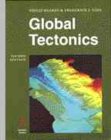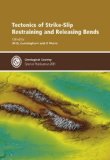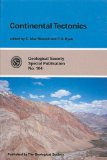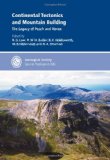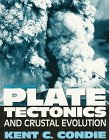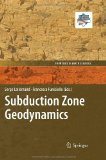Tectonics
- 3-D thermo-mechanical laboratory modeling of plate-tectonics: modeling scheme, technique and first experiments

- A Model Of Sea Floor Spreading
- A Subduction Zone
- A global-scale plate reorganization event at 105-100 Ma

- ABC's of Plate Tectonics
- Absolute plate motions and regional subduction evolution

- Active Tectonics
- Anatomy and Ontogeny of Modern Intra-Oceanic Arc Systems

- Balancing the force budget of plate tectonics along the Nazca/South America plate margin

- Bonn University Lehrstuhl Geodynamik der Lithosphere
- California Institute of Technology - Tectonics Observatory
- Canadian Tectonics Group
- CDDIS Crustal Dynamics Data Information System
- Conjugate divergent margins: An introduction

- Consequences of crustal melting in continental subduction

- Consequences of Plate Tectonics
- Continental collision and the tectono-sedimentary evolution of forelands
- Continental Drift & Plate Tectonics
- Convergence in tectonic reconstructions and mantle convection models for significant fluctuations in seafloor spreading

- Convergent Plate Boundaries

- Detecting Large-scale Intracontinental Slow-slip Events (SSEs) Using Geodograms

- Differential preservation in the geologic record of intraoceanic arc sedimentary andtectonic processes

- Differentiation of the Continental Crust by Relamination

- Discovering Plate Boundaries
- Divergent Plate Boundaries

- Dynamics and stress field of the Eurasian plate: A combined lithosphere-mantle approach

- Dynamics of interplate domain in subduction zones: influence of rheological parameters and subducting plate age

- Dynamics of subduction and continental collision: Influence of the nature of the plate contact

- EarthByte - research group for global and regional plate tectonic reconstructions and for studying the interplay between the deep earth and surface processes
- Earthquakes and Plate Tectonics
- Evaluating a 2-D Structural Restoration: Validating Section Balance

- Evidence for Plate Tectonics
- Exercise on Subduction
- Experimental Researches of Geodynamic Processes
- Extensional Tectonics at Rutgers
- Fault-zone geology: lessons from drilling through the Nojima and Chelungpu faults

- Fold-Thrust Interactions in the Canadian Rocky Mountains Revisited - A New Kinematic Model and its Implications for Other Shallow Fold-Thrust Belts

- Formation Mechanism of Island Arc

- From Faults to Plate Boundaries: Insights from Computer Models

- Géodynamique
- Geodynamic evolution of the Alpine Tethys
- Geodynamics at Caltech
- Geodynamics Home Page
- GEO121 - Principles of Global Dynamics
- GEOL 15 - The Dynamic Earth
- GEOL 456/656 - Plate Tectonic Theory
- Geo-tectonics discussion list
- Geological and geophysical characterization of accretionary and collisional systems : the Central Asian Orogenic Belt and the Bohemian Massif

- GeoPrisms - Geodynamic Processes at Rifting and Subducting Margins
- Global continental and ocean basin reconstructions since 200 Ma

- Global Tectonics
- Glossaire de Tectonique generale
- Hot spots and mantle plumes
- Hotspots and Mantle Plumes

- Hotspots: Thermal Mantle Plumes
- IMSA Earthquakes and Plate Tectonics
- INQUA Commission on Neotectonics
- Insight into collision zone dynamics from topography: numerical modelling results and observations

- Institute of Tectonic Studies - New Mexico State University
- Inteactives Dynamic Earth
- International Lithosphere Program (ILP)
- Introduction to Plate Tectonics
- Introduction to Plate Tectonics
- Investigation of Hot Spots
- Links between long-lived hotspots, mantle plumes, D", and plate tectonics

- Lower Mantle Structure from paleogeographically constrained dynamic Earth models

- Manufacturing Continental Crust in the Subduction Factory: Was Continent Born in the Ocean?

- MARGINS Program
- Microstructural evolution and seismic anisotropy of upper mantle rocks in rift zones

- Moho: Boundary above upper mantle peridotites or lower crustal eclogites? A global assessment of passive margins

- Moving hotspots: Evidence from paleomagnetism and modeling

- Moving Mountains - The Story of a Revolution
- Next-generation plate-tectonic reconstructions using GPlates

- Numerical models of slab migration in continental collision zones

- ODSN Plate Tectonic Reconstruction Service
- Organisation of the tectonic plates in the last 200 Myr

- Paradigms, new and old, for ultrahigh-pressure tectonism

- Phys 1417.01 - Plate Tectonics
- Plate motion and mantle plumes

- Plate Reconstructions
- Plate tectonic reconstructions with continuously closing plates

- Plate Tectonics - The Geological Society
- Plate Tectonics
- Plate Tectonics
- Plate Tectonics
- Plate Tectonics
- Plate Tectonics
- Plate Tectonics

- Plate Tectonics: A Whole New Way of Looking at Your Planet
- Plate Tectonics and Plate Tectonics Animation
- Plate Tectonics and Sea-Floor Spreading, Subduction Zones, Hot Spots, and the Ring of Fire
- Plate Tectonics and the Formation of Magma
- Plate Tectonics - Geological Aspects
- Plate Tectonics Model
- Plate Tectonic Reconstructions at UTIG
- Plate Tectonics, the Cause of Earthquakes
- Principles of Global Dynamics
- Quantifying the thermo-mechanical impact of plume arrival on continental break-up

- Quantitative filling model for continental extensional basins
- Rapid fore-arc extension and detachment-mode spreading following subduction initiation

- Reorganization of convergent plate boundaries

- Rodinia2013: Supercontinental Cycles and Geodynamics - 20-24 May 2013, Moscow, Russia
- Role of the overriding plate in the subduction process: Insights from numerical models

- Salt Tectonics
- Sea level and vertical motion of continents from dynamic Earth models since the Late Cretaceous

- Seafloor Topography
- Simplified Tectonic Map of the World, Including Major Basins

- Structural and stratigraphic evolution of extensional oceanic arcs

- Subduction Initiation: Spontaneous and Induced

- Subduction to the lower mantle – a comparison between geodynamic and tomographic models

- Teacher's Domain: Plate Tectonics
- Tectonic Park
- Tectónica laminar
- Tectonics: Sinking Continents

- Tectonics and Landscapes

- Texas University at Dallas - Center for Lithospheric Studies
- Thermomechanics of mid-ocean ridge segmentation

- This Dynamic Earth: the Story of Plate Tectonics
- Three-dimensional thermal structure of subduction zones: effects of obliquity and curvature

- Transform Plate Boundaries

- TSG 2002 - Annual meeting of the Tectonic Studies Group, January 7-9, 2002, Leicester
- Une Theorie planetaire la Tectonique des Plaques
- Unterschiedliche Theorien zur Plattentektonik
- Using open sidewalls for modelling self-consistent lithosphere subduction dynamics

- Vrije University Amsterdam - Tectonics Department
- When Did Plate Tectonics Begin? Theoretical and Empirical Considerations

- Yin and Yang of Continental Crust Creation and Destruction by Plate Tectonics

Books about tectonics
| Global Tectonics The third edition of this widely acclaimed textbook provides a comprehensive introduction to all aspects of global tectonics, and includes major revisions to reflect the most significant recent advances in the field. A fully revised third edition of this highly acclaimed text written by eminent authors including one of the pioneers of plate tectonic theory Major revisions to this new edition reflect the most significant recent advances in the field, including new and expanded chapters on Precambrian tectonics and the supercontinent cycle and the implications of plate tectonics for environmental change Combines a historical approach with process science to provide a careful balance between geological and geophysical material in both continental and oceanic regimes. |
|
Tectonics of Strike-Slip Restraining and Releasing Bends |
|
| Continental Tectonics The evolution of oceanic plates is very well described by plate tectonic theory, but the study of continental tectonics is more complicated. Continental plates have a different rheology, a greater mean age, a higher heat productivity, and are more heterogeneous in composition. An understanding of continental tectonics requires, therefore, that these effects upon rigid plate behaviour be taken into account. This book brings together a series of papers which explore various aspects of the deformation of continental lithosphere, covering different tectonic settings from the Palaeozoic to the present day. These include the processes of terrane accretion and juxtaposition, the exhumation of high-pressure terrains, and mechanisms of crustal extension and rifting. The book will be of general interest to a broad audience of earth scientists concerned with global tectonics, continental growth processes, and the deformation of the continents during collision, exhumation and extension. |
|
| Continental Tectonics and Mountain Building The worlds mountain ranges are the clearest manifestations of long-term deformation of the continental crust. As such they have attracted geological investigations for centuries. Throughout this long history of research a few keynote publications stand out. One of the most important is the Geological Surveys 1907 Memoir on The Geological Structure of the North-West Highlands of Scotland. The Memoir summarized some of the Geological Survey's finest work, and outlined many of the principles of field-based structural and tectonic analysis that have subsequently guided generations of geologists working in other mountain belts, both ancient and modern. The thematic set of 32 papers in this Special Publication celebrate the 100th anniversary of the 1907 Memoir by placing the original findings in both historical and modern contexts, and juxtaposing them against present-day studies of deformation processes operating not only in the NW Highlands, but also in other mountain belts. |
|
| Plate Tectonics: Continental Drift and Mountain Building How are mountains formed? Why are there old and young mountains? Why do the shapes of South America and Africa fit so well together? Why is the Pacific surrounded by a ring of volcanoes and earthquake-prone areas while the edges of the Atlantic are relatively peaceful? Frisch and Meschede and Blakey answer all these questions and more through the presentation and explanation of the geodynamic processes upon which the theory of continental drift is based and which have led to the concept of plate tectonics. |
|
| Subduction Zone Geodynamics Subduction is a major process that plays a first-order role in the dynamics of the Earth. The sinking of cold lithosphere into the mantle is thought by many authors to be the most important source of energy for plates driving forces. It also deeply modifies the thermal and chemical structure of the mantle, producing arc volcanism and is responsible for the release of most of the seismic energy on Earth. There has been considerable achievements done during the past decades regarding the complex interactions between the various processes acting in subduction zones. This volume contains a collection of contributions that were presented in June 2007 in Montpellier (France) during a conference that gave a state of the art panorama and discussed the perspectives about "Subduction Zone Geodynamics". The papers included in this special volume offer a unique multidisciplinary picture of the recent research on subduction zones geodynamics. They are organized into five main topics: Subduction zone geodynamics, Seismic tomography and anisotropy, Great subduction zone earthquakes, Seismogenic zone characterization, Continental and ridge subduction processes. Each of the 13 papers collected in the present volume is primarily concerned with one of these topics. However, it is important to highlight that papers always treat more than one topic so that all are related lighting on different aspects of the complex and fascinating subduction zones geodynamics. |
